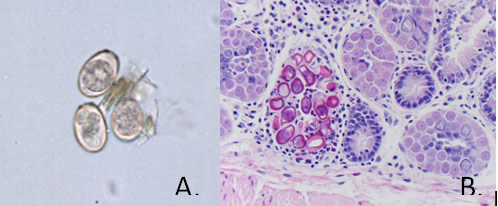Etiology: Eimeria are eukaryotic, one-celled parasites. Eimeria intestinalis, E. magna, E. irresidua, and E. flavescens are regarded as the most pathogenic species. E. perforans, E. media, E. magna, and E. irresidua are the most frequently observed species. All species infect the intestinal tract and replicate in the absorptive epithelium of the mucosa.
Incidence: Incidence of infection is high.
Transmission: Transmission occurs by ingestion of sporulated oocysts.
Clinical Signs: Signs vary and are most severe in young rabbits. Poor weight gain, dehydration, polydipsia, and intermittent to profuse mucoid, watery, or hemorrhagic diarrhea with perineal fecal staining may occur. Secondary bacterial infections may develop and cause acute death. Older rabbits may shed coccidial oocysts without expression of clinical disease.
Pathology: Grossly, fluid intestinal contents are often observed in heavily parasitized rabbits. Multiple white patches on the mucosal surface of the small or large intestine may be observed. Histologically, mucosal erosions, edema, heterophilic infiltrates, villous collapse in the small intestine, and crypt hyperplasia may be seen. Coccidian forms can be observed in the mucosa.
Diagnosis: Antemortem diagnosis can be made by examination of feces by direct smear, flotation, or concentration/flotation methods (A.). A postmortem diagnosis can be made by examination of mucosal scrapings or by histologic observation of coccidial organisms in sections of intestine (B.).
